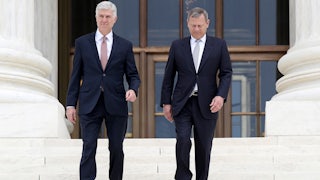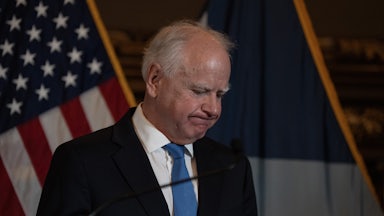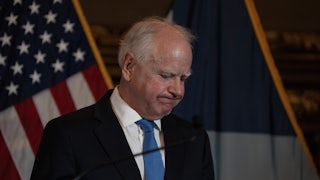The Supreme Court released its decision in American Hospital Association v. Becerra last week. While the case wasn’t as high profile as some of the others on the docket this term, it was poised to be a significant ruling nonetheless. The justices agreed to hear it last summer to determine the scope of a legal doctrine known as “Chevron deference,” all rooted in an underlying dispute over Medicare reimbursement rates.
Chevron deference, put simply, is a test that courts use when deciding whether a federal agency is properly exercising the power given to it by Congress. It draws its name from a 1984 Supreme Court ruling in which the court articulated the doctrine in detail. It typically requires courts to defer to an agency’s own interpretation of federal law in cases where Congress was vague or unclear about the scope of that agency’s power. This precedent is a pillar of the modern federal bureaucracy’s legal authority—and, accordingly, a perennial target of criticism from the conservative legal movement.
Some observers suggested last year the court could use Becerra to limit or alter the doctrine substantially, making it easier for judges to second-guess when and how federal agencies exercise their power. The court is fighting similar battles on other fronts, which I’ll discuss later, but Chevron deference stands out both for its importance—revising it could open up a much greater swath of federal regulatory decisions to legal challenges—and for the frequency with which conservative justices have lambasted it.
That made it all the more striking last Wednesday when the court—well … didn’t really answer the question at all. In a unanimous opinion written by Justice Brett Kavanaugh, the court held that the Department of Health and Human Services had improperly set its reimbursement rates for hospitals. The 17-page decision had no concurring opinions and, obviously, no dissenting ones. Even more curiously, it was missing something else entirely: any mention of Chevron deference whatsoever.
At issue in Becerra are the incredibly complex ways in which the Medicare program reimburses some hospitals for outpatient prescription drugs—and, accordingly, how billions of dollars in federal funds are allocated to the nation’s health care system. The hospitals in question are nonprofit hospitals that serve lower-income and rural communities that fall under a provision known as Section 340B. That provision requires pharmaceutical companies to sell their products to Section 340B hospitals at below-market rates.
A different provision in federal law lays out two ways in which the Medicare program can figure out how much it must reimburse all hospitals, including non–Section 340B ones, for prescription drugs. Congress gave the Department of Health and Human Services two choices. One option is to conduct a survey of drug costs at various U.S. hospitals and then use that data to set the average price. The other option, which can be used if that survey data isn’t available, is to simply set the average price for reimbursement at 106 percent of a drug’s average sale price. Starting in 2003, when Congress enacted this particular scheme, HHS declined to conduct a survey and relied on option two to figure out reimbursement costs.
All of that changed in 2018 when the Trump administration tried to do things differently. In practice, the interaction between the 106 percent provision and the Section 340B program had been a fiscal boon to the participating hospitals. Not only were those hospitals paying heavily discounted rates for prescription drugs, but Medicare was also reimbursing them not only for the full price of those drugs but also with an extra 6 percent thrown in. Neither Congress nor HHS previously saw fit to change anything because, among other reasons, it effectively provided a backdoor way to subsidize hospitals in the poorest parts of the country.
To the Trump administration, however, the two provisions resulted in what it saw as significant overpayments to 340B hospitals. So in 2018, it tried to adjust the reimbursement rate for 340B hospitals by using the average cost they paid for drugs instead of the average sale price of those drugs. The American Hospital Association responded to the proposed change by suing HHS, arguing that the relevant provisions of Medicare’s laws only allowed the department to set different rates for different hospitals, which it had not done. The Trump administration countered that its differing interpretation of the statute was a reasonable one.
That’s where Chevron deference comes in. The doctrine has a two-step test for judges to use. First, the judge looks at whether Congress spoke clearly on the matter in question in the relevant law. If Congress did so, then the judge must generally rely upon what Congress said. If Congress didn’t address it, however, then the judge moves to the next step. There, the judge looks at whether the agency’s interpretation of the statute in question is a “permissible construction” of its meaning. That extremely lenient test is one that the government almost always passes.
Unsurprisingly, that deferential attitude toward federal agencies doesn’t sit well with many in the conservative legal movement. The doctrine’s defenders have cast it as an act of judicial humility, leaving the granular issues of policymaking to Congress’s designated agencies instead of unelected judges. Conservative Supreme Court justices, most notably Justice Neil Gorsuch and Chief Justice John Roberts, have described it as incompatible with the judiciary’s duty to interpret the law.
In last Wednesday’s ruling, the court unanimously sided with the hospitals against the Trump administration’s reading of the statute. (The Biden administration continued to defend the case in court because of the underlying legal implications.) Kavanaugh, writing for the unanimous court, said that option one expressly gave HHS the authority to set different rates for different hospitals if the department had carried out a survey of hospital costs. Since that language wasn’t also present in option two, Kavanaugh concluded that Congress intended for HHS to enact a uniform rate across hospitals if it took that path.
“In short, the statute allows HHS to set reimbursement rates based on average price and affords the agency discretion to ‘adjust’ the price up or down,” he noted. “But unless HHS conducts a survey of hospitals’ acquisition costs, HHS may not vary the reimbursement rates by hospital group.” Kavanaugh added that the court “must hesitate to adopt an interpretation that would eviscerate such significant aspects of the statutory text.” (A separate issue was whether the rate changes were subject to judicial review at all; the court said the jurisdiction-limiting provisions of the Medicare laws didn’t apply to this specific part.)
On its face, that sounds a lot like the Supreme Court applied Chevron deference. The justices reached the first step, found that Congress had spoken clearly on the question at hand, and then deferred to what Congress had decided. What makes the ruling weird is that Kavanaugh’s majority opinion does not mention Chevron deference at all. It does not describe the two-part test, let alone explicitly apply it. Kavanaugh does not even cite Chevron once to reach the decision, even though the actual question presented by the hospitals in their petition for review was “whether Chevron deference permits HHS to set reimbursement rates based on acquisition cost and vary such rates by hospital group if it has not collected adequate hospital acquisition cost survey data.”
By not addressing Chevron deference, the court did not really answer that question. It simply solved the underlying problem. The practical effect is that Chevron remains alive and well for lower courts to follow whenever relevant. Even though the court didn’t use it in this case, it didn’t overturn it or limit it either. So unless there’s something that was missed by the court’s liberals, who have voted to uphold the Chevron status quo in the past, then the latest effort to curb or roll back the doctrine appears to have been a bust.
This isn’t the first time that a bid to rewrite administrative law by the court’s conservatives fell flat. In 2019, the court took up Gundy v. United States, which involved a federal sex-offender registration law known as SORNA, to address questions about something known as “nondelegation doctrine.” That doctrine has been moribund for nearly a century; it generally held that Congress cannot delegate its legislative powers to another branch of government. Herman Gundy, the defendant in that case, argued that Congress did so with SORNA by leaving most of its implementation up to the attorney general.
Some conservative legal scholars have called for the nondelegation doctrine’s revival in a bid to further limit the power of federal regulatory agencies. As with their hostility to Chevron deference, their basic aim is to make it harder for agencies to act decisively and broadly to address public policy issues, at least not without running every detail by donor-reliant legislators in a gerrymandered House and a filibustered Senate first. In Gundy, however, the conservatives failed to keep up a united front. All four liberals at the time ruled in favor of the government. “If SORNA’s delegation is unconstitutional, then most of government is unconstitutional,” Justice Elena Kagan wrote for the plurality.
Justice Samuel Alito provided the fifth vote, but only for the outcome and not for his liberal colleagues’ reasoning. “If a majority of this Court were willing to reconsider the approach we have taken for the past 84 years, I would support that effort,” he wrote in a concurring opinion. “But because a majority is not willing to do that, it would be freakish to single out the provision at issue here for special treatment.” When Gundy was argued in October 2018, Kavanaugh had not yet been confirmed to the court and therefore couldn’t take part in the decision, leaving the conservatives with only four votes. The court has yet to take up another nondelegation case.
Unlike in Gundy, it’s unknown what went on behind the scenes in Becerra. What is known is that oral arguments were held in November and that the decision wasn’t released until June. It’s improbable that it took Kavanaugh roughly six months to write a unanimous 17-page opinion. One possibility is that no five-justice majority came together on the Chevron aspect of the case, and that the justices eventually coalesced around a narrower unanimous opinion that avoided mentioning it altogether. Another possibility is that the justices were unanimous about the statute’s unambiguous nature from the start and opted to avoid discussing Chevron for simplicity’s sake. How exactly that behind-the-scenes debate played out would be salient to future disputes over the doctrine.
Those in favor of robust federal regulatory power can’t breathe easy just yet, because one such dispute is still on the docket. In the next fortnight or so, the court will also hand down its decision in West Virginia v. Environmental Protection Agency. That case is yet another instance where the conservative justices could write or rewrite an existing precedent—in this case, the so-called “major questions doctrine”—to make it harder for federal agencies to carry out their missions or for Congress to legislate in broad terms. If the EPA can’t regulate carbon emissions under existing laws because Congress didn’t speak clearly enough on a major policy issue, whatever that means, then we may need to redefine “Chevron deference” when it comes to this court.










